Europe Prefabricated Buildings Market Size
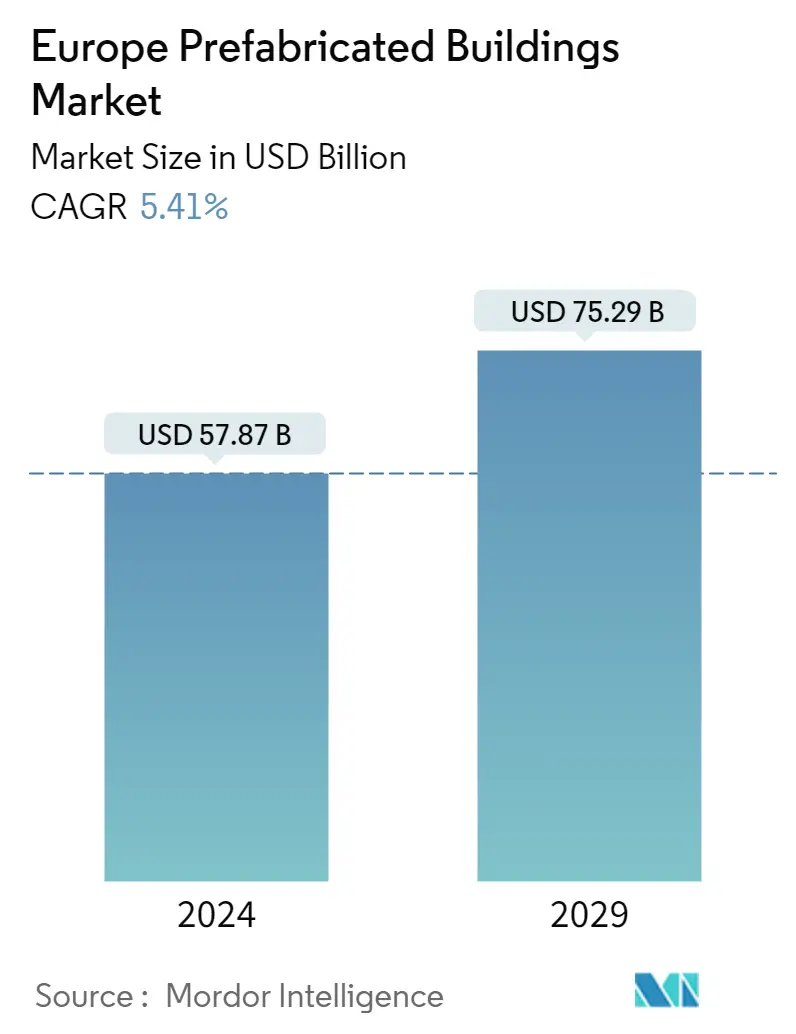
| Study Period | 2020 - 2029 |
| Market Size (2024) | USD 57.87 Billion |
| Market Size (2029) | USD 75.29 Billion |
| CAGR (2024 - 2029) | 5.41 % |
| Fastest Growing Market | North America |
| Largest Market | North America |
Major Players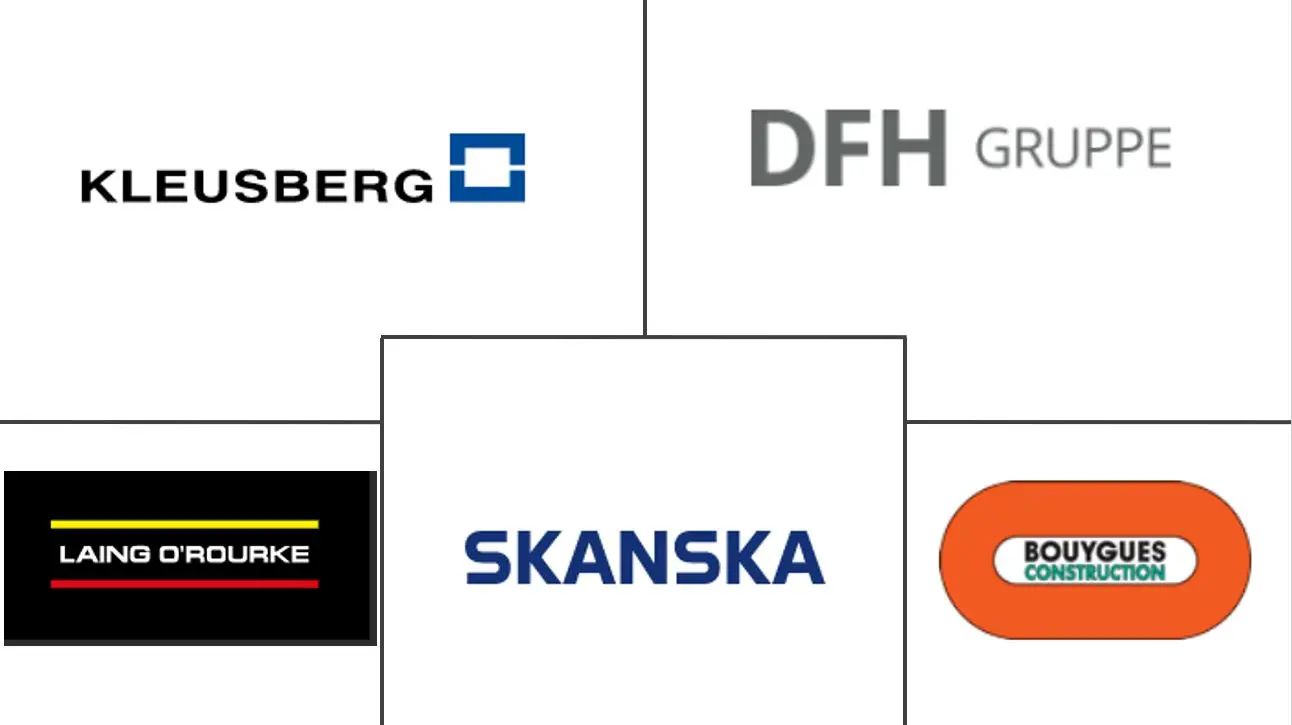
*Disclaimer: Major Players sorted in no particular order |
Europe Prefabricated Buildings Market Analysis
The Europe Prefabricated Buildings Market size is estimated at USD 57.87 billion in 2024, and is expected to reach USD 75.29 billion by 2029, growing at a CAGR of 5.41% during the forecast period (2024-2029).
The outbreak of the COVID-19 pandemic has led to severe uncertainty for vendors and contractors in the construction industry across Europe. Several construction companies shut down their projects due to lockdowns and restrictions. However, due to immediate requirements for hospitals and quarantine sectors, the demand for prefabricated materials witnessed an increase. Since a high workforce is required for traditional construction, opting for prefabricated buildings became an optimum solution during the pandemic.
The market is expanding as the demand for higher-quality, environment-friendly homes rise across the continent, with the United Kingdom and Germany accounting for the highest proportions. The adoption of additive manufacturing in Europe is expected to significantly boost the prefabricated construction sector. Companies embrace environment-friendly products and production practices to differentiate themselves from the competition. The introduction of energy-absorbing materials such as micro dwellings has resulted from focusing on energy efficiency.
Prefabricated housing demand is rising as the building technique's advantages are increasingly being leveraged by new home buyers in an improving economic and demographically charged marketplace. By the end of 2022, an estimated 70,100 units are anticipated to be sold across six Northern European countries, with the German demand representing a sizeable level, particularly for turnkey solutions.
Europe Prefabricated Buildings Market Trends
This section covers the major market trends shaping the Europe Prefabricated Buildings Market according to our research experts:
Wooden Prefabricated Buildings Hold the Largest Share in the Sector
In Italy, the prefabricated market for wood goods is expanding, as seen by the increased production of cross-laminated timber (CLT). CLT output in the "DACH" region (Germany, Austria, and Switzerland), the Czech Republic, and Italy totals over 750,000 m3 and is increasing at a rate of more than 10% per year. In 2016, the Russian government established requirements for the use of wood in state housing programmed construction: 30% in 2018, 35% in 2019, 40% in 2020, and 45% in 2021.
The Segezha Group is the market leader in glulam-based construction in Russia. Sokol Timber Company, a Segezha subsidiary, is a large industrial home-building factory that primarily manufactures glued wood for export. Segezha Group began construction on a CLT manufacturing factory with a production capacity of 250,000 m2 per year in June 2019. The use of steel in infrastructure, housing, communal, and social construction is growing in Russia, owing to the high environmental friendliness of metal constructions throughout their life cycle and increased infrastructure investment. Timber building is becoming increasingly popular in France. It has traditionally accounted for a smaller percentage of all apartment buildings and has been reserved mostly for structures up to four stories tall. There are already an increasing number of projects underway for buildings with seven to 16 stories that use timber for the shell or structure of the building. For the next 15 years, the city of Bordeaux in southwestern France has vowed to develop 270,000 square feet of wooden spaces per year. The Hyperion tower, an 18-story residential structure with CLT floors and walls, is one of the buildings leading the way. It is expected to be one of the tallest global timber buildings.
Products created from various materials compete with precast concrete products. For example, precast concrete rail sleepers compete to some extent with rail sleepers constructed of wood, steel, and plastic in the rail sleepers market, which is the main end user of precast concrete. In France, wooden rail sleepers account for 15% of total rail sleepers in terms of volume (owing to a statute requiring 250,000 rail sleepers per year to be constructed of wood due to an agreement with the timber sector), while precast concrete accounts for 100% of the remaining rail sleeper market.
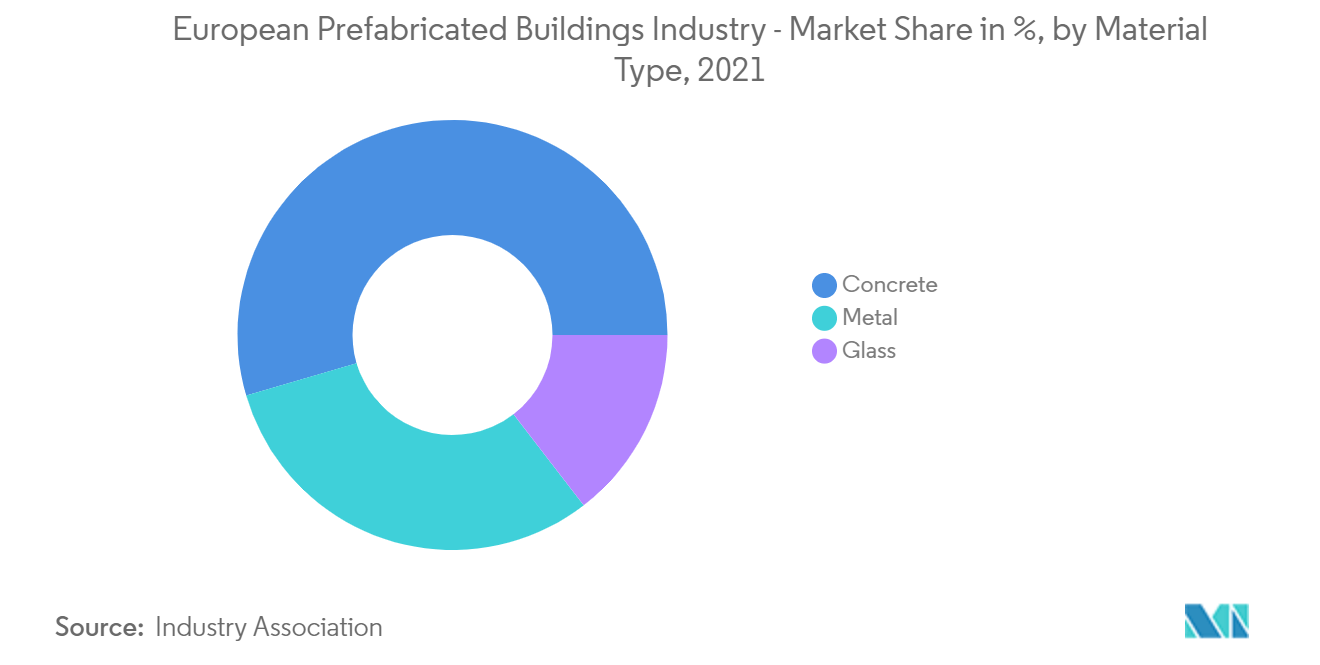
Increase in Investments in the UK Prefab Industry may Boost the Market
According to the National House Building Council (NHBC), the number of new homes registered to be built in the United Kingdom decreased by 23.2% in 2021, to 123,151, the lowest level since 2012 (104,922). The NHBC also stated that new home registrations fell in every UK region in 2021, with the largest drops occurring in the second quarter. According to data from the Office for National Statistics, in the second quarter of 2021, new housing construction orders in the private market explicitly - seasonally adjusted, volume - were up by 4.6% quarter-on-quarter and 154.8% Y-o-Y, indicating that the order book for property developers is on the mend following the lockdown.
As the UK government plans to build around 300,000 new homes per year by 2022 to address the challenges in the housing market, prefab construction is expected to play a significant role there. In addition, in June 2019, the Worthing council permitted Ikea to build modular homes on the south coast in a joint venture with the construction firm Skanska. The two companies, Ilke Homes and Legal & General, have built factories to manufacture prefab homes. These two companies are transforming the prefabricated housing industry in the country with the production of two- and three-bedroom homes that range between GBP 65,000 to GBP 79,000. Ilke Homes pledged to produce 2,000 houses a year, eventually reaching 5,000. The insurance company Legal & General has built a vast factory outside Leeds, which may build 3,500 homes a year.
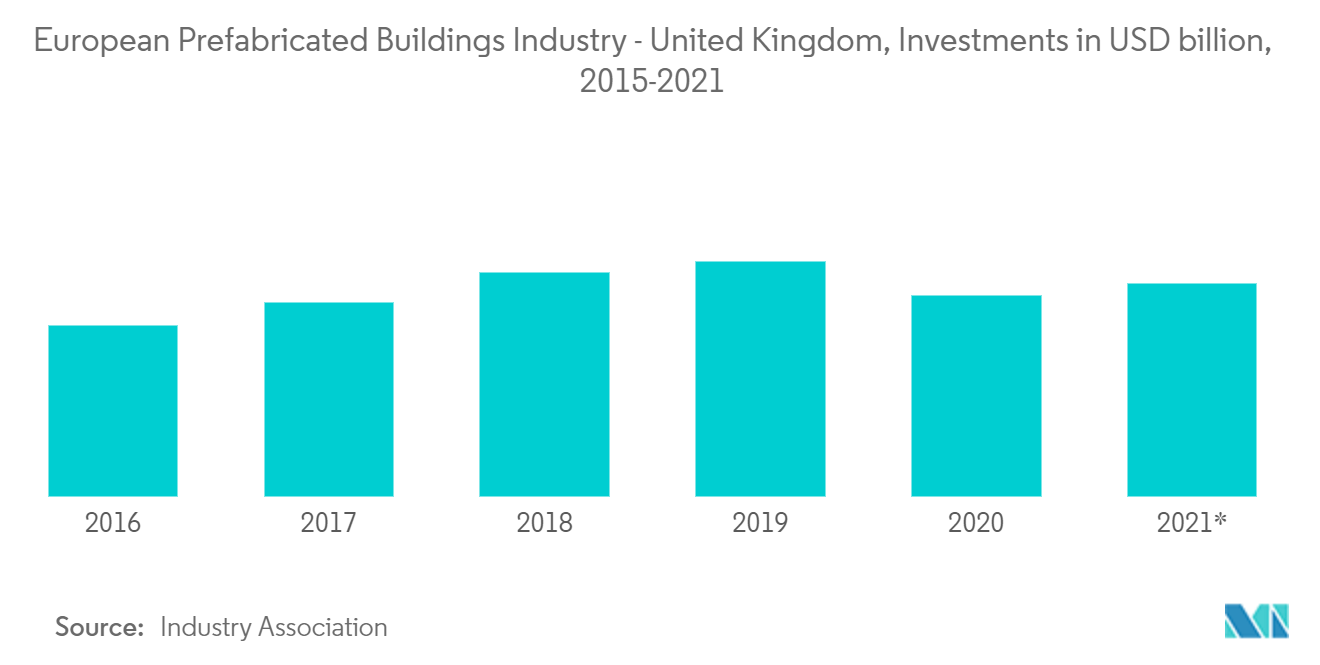
Europe Prefabricated Buildings Industry Overview
The European prefabricated buildings market is fragmented with many players. The market is highly competitive, with no players occupying the major share. Some of the major players in the market are Laing O-Rourke, Bouygues Construction, Skanska AB, Kleusberg GmbH, and Deutsche Fertighaus Holding.
Europe Prefabricated Buildings Market Leaders
-
Laing O-Rourke
-
Bouygues Construction, VINCI
-
Skanska AB
-
Kleusberg GmbH & Co. (KG)
-
Deutsche Fertighaus Holding
*Disclaimer: Major Players sorted in no particular order
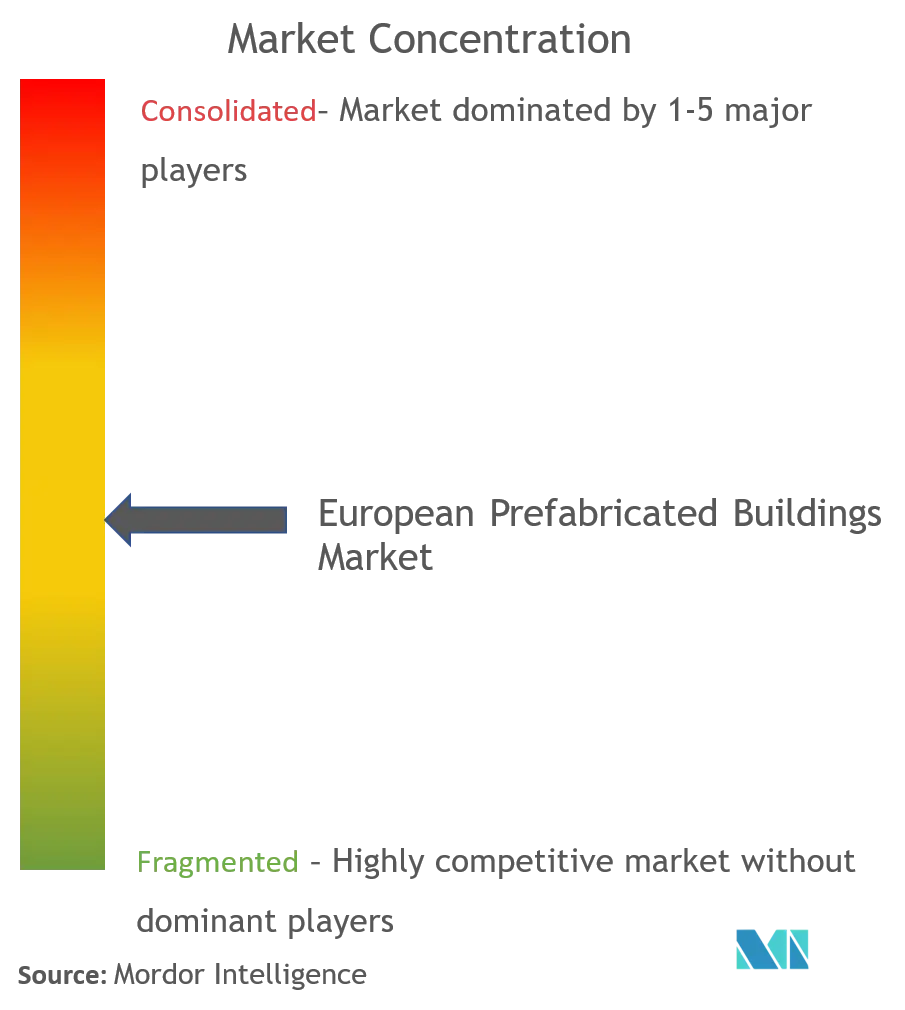
Europe Prefabricated Buildings Market News
In January 2022, the University of Oxford appointed its long-standing partner, Laing O'Rourke to deliver the Stephen A. Schwarzman Centre for the Humanities. The award could signify one of the university's largest single-building projects and would see Laing O'Rourke deliver its 12th project for a client it has worked with for two decades. The new building is estimated to bring nine faculties, institutes, and seven libraries and collections into one home, with sustainable, flexible, accessible spaces for graduate postgrad and post-doc learning, research, and experimentation. Performance and public engagement spaces form a key element of the project, with a 500-seat concert hall designed with global-leading acoustic capability, a 250-seat theater, and a film screening area. It is estimated to form the centerpiece of the Radcliffe Observatory Quarter (ROQ) and is estimated to be surrounded by an inviting landscaped space, connecting the wider community throughout.
In August 2021, Uliving, a brand of Linkcity UK (the property development subsidiary of Bouygues UK) specializing in student accommodation, won a 50-year concession contract to construct and provide facilities management services for a 1,262-bedroom project at the University of Essex in consortium with Equitix, its equity partner. The contract is worth GBP 168 million (EUR 194 million).
Europe Prefabricated Buildings Market Report - Table of Contents
1. INTRODUCTION
- 1.1 Study Assumptions and Market Definitions
- 1.2 Scope of the Study
2. RESEARCH METHODOLOGY
- 2.1 Analysis Methodology
- 2.2 Research Phases
3. EXECUTIVE SUMMARY
4. MARKET INSIGHTS
- 4.1 Current Market Scenario
- 4.2 Technological Trends
- 4.3 Insights into Supply Chain/Value Chain Analysis of the Prefabricated Buildings Industry
- 4.4 Brief on Different Structures Used in the Prefabricated Buildings Industry
- 4.5 Cost Structure Analysis of the Prefabricated Buildings Industry
- 4.6 Impact of COVID-19 on the Market
5. MARKET DYNAMICS
- 5.1 Drivers
- 5.2 Restraints
- 5.3 Opportunitites
-
5.4 Porter's Five Forces Analysis
- 5.4.1 Bargaining Power of Suppliers
- 5.4.2 Bargaining Power of Consumers/Buyers
- 5.4.3 Threat of New Entrants
- 5.4.4 Threat of Substitute Products
- 5.4.5 Intensity of Competitive Rivalry
6. MARKET SEGMENTATION
-
6.1 By Application
- 6.1.1 Residential
- 6.1.2 Commercial
- 6.1.3 Other Applications (Industrial, Institutional, and Infrastructure)
-
6.2 By Geography
- 6.2.1 Belgium
- 6.2.2 Finland
- 6.2.3 France
- 6.2.4 Germany
- 6.2.5 Italy
- 6.2.6 Rest of Europe
7. COMPETITIVE LANDSCAPE
- 7.1 Overview (Market Concentration and Major Players)
-
7.2 Company Profiles
- 7.2.1 Laing O-Rourke
- 7.2.2 Bouygues Construction
- 7.2.3 Skanska AB
- 7.2.4 Kleusberg GmbH & Co. (KG)
- 7.2.5 Deutsche Fertighaus Holding
- 7.2.6 Berkley Homes
- 7.2.7 Ilke Homes
- 7.2.8 Segezha Group
- 7.2.9 Moelven Byggmodul AB
- 7.2.10 ALHO Systembau GmbH
- 7.2.11 Fertighaus Weiss GmbH *
- *List Not Exhaustive
8. MARKET OPPORTUNITIES AND FUTURE TRENDS
9. APPENDIX
- 9.1 Macroeconomic Indicators (GDP Breakdown by Sector, Contribution of Construction to Economy, etc.)
- 9.2 Key Production, Consumption, and Export and Import Statistics of Construction Materials
Europe Prefabricated Buildings Industry Segmentation
The European prefabricated buildings market covers growing trends and projects like commercial, residential, and industrial construction. The report also covers the industry and materials used, like concrete, timber, glass, metal, and other types. The market scope has been extended to provide insights at the regional level by segmenting across geography. Along with the report's scope, it also analyzes the key players and the competitive landscape in the market. The impact of COVID-19 has also been incorporated and considered during the study.
| By Application | Residential |
| Commercial | |
| Other Applications (Industrial, Institutional, and Infrastructure) | |
| By Geography | Belgium |
| Finland | |
| France | |
| Germany | |
| Italy | |
| Rest of Europe |
Europe Prefabricated Buildings Market Research FAQs
How big is the Europe Prefabricated Buildings Market?
The Europe Prefabricated Buildings Market size is expected to reach USD 57.87 billion in 2024 and grow at a CAGR of 5.41% to reach USD 75.29 billion by 2029.
What is the current Europe Prefabricated Buildings Market size?
In 2024, the Europe Prefabricated Buildings Market size is expected to reach USD 57.87 billion.
Who are the key players in Europe Prefabricated Buildings Market?
Laing O-Rourke, Bouygues Construction, VINCI, Skanska AB, Kleusberg GmbH & Co. (KG) and Deutsche Fertighaus Holding are the major companies operating in the Europe Prefabricated Buildings Market.
Which is the fastest growing region in Europe Prefabricated Buildings Market?
North America is estimated to grow at the highest CAGR over the forecast period (2024-2029).
Which region has the biggest share in Europe Prefabricated Buildings Market?
In 2024, the North America accounts for the largest market share in Europe Prefabricated Buildings Market.
What years does this Europe Prefabricated Buildings Market cover, and what was the market size in 2023?
In 2023, the Europe Prefabricated Buildings Market size was estimated at USD 54.90 billion. The report covers the Europe Prefabricated Buildings Market historical market size for years: 2020, 2021, 2022 and 2023. The report also forecasts the Europe Prefabricated Buildings Market size for years: 2024, 2025, 2026, 2027, 2028 and 2029.
Europe Prefabricated Buildings Industry Report
Statistics for the 2024 Europe Prefabricated Buildings market share, size and revenue growth rate, created by Mordor Intelligence™ Industry Reports. Europe Prefabricated Buildings analysis includes a market forecast outlook to 2029 and historical overview. Get a sample of this industry analysis as a free report PDF download.



